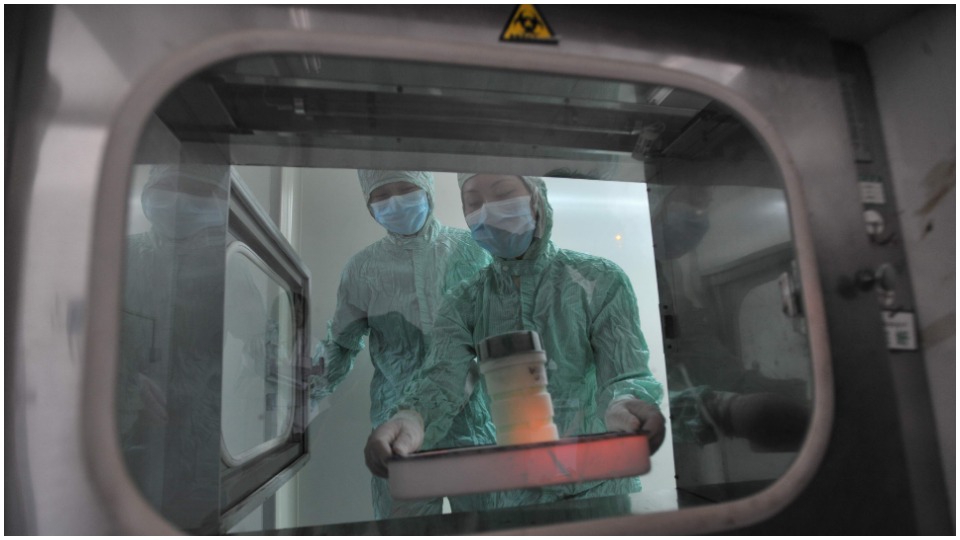
As COVID-19 maintains its devastating spread throughout the world, it has found an unlikely ally: The United States government.
Case and fatality counts in the U.S. continue to rise—nearly 1.4 million infected and over 80,000 dead as of May 11—but rather than take stock of its disastrous response and chart a new course, the U.S. appears poised to double down on its cataclysmic policies by stoking acrimony toward countries that have successfully contained their own outbreaks. As is so often the case lately, the prime target is China.
More specifically the target is the Wuhan Institute of Virology, a Biosafety Level 4 lab working on the front lines of epidemic detection and prevention since its opening in 2015. It, along with other Chinese medical facilities, contributed to the sequencing and publication of the virus’s genetic code. This allowed the world to begin research into the vaccines and treatments that will save countless lives. Despite the essential role it has played in combating the outbreak, the institute’s work with bat coronaviruses has fallen under a great deal of scrutiny. This is because the natural reservoir of the novel coronavirus—and by extension, the origin of the COVID-19 pandemic—is almost assuredly bats.
An unfortunate coincidence—and one that has thrown fuel on the conspiratorial fire. Crackpot theories that used to be the exclusive domain of the fringe are now finding purchase in the mainstream. Secretary of State Mike Pompeo has been at the fore of this disinformation offensive, implying on several occasions that the institute has something to hide. He has not, of course, provided any evidence to back these charges. Perhaps as a former director of the Central Intelligence Agency, he’s grown used to lying every time he opens his mouth.
To no one’s great surprise, this isn’t the first time the WIV has been used as a political football. Earlier in the year—when the outbreak was considered a “Chinese problem” and figures in the U.S. gleefully predicted the country’s demise—a wildly inflammatory claim was floated by prominent hawks like Arkansas Republican Sen. Tom Cotton and former White House strategist Steve Bannon.
With vague, insinuating language, they began “just asking questions” about the institute and its role in the spread of the virus. Few mainstream outlets took the bait, and scientists were quick to dismiss the idea COVID-19 was created in a lab. As even the most basic level of analysis reveals no signs of human tampering or modification, the prevailing opinion among scientists worldwide is the virus is zoonotic, or of natural origin.
But that didn’t stop the media-industrial complex in its ongoing efforts to shift culpability for the virus onto China. An alternative theory emerged, one which sounds more reasonable to the average person but has the same level of proof—that is to say, none whatsoever. Hence the hubbub over a supposed “lab leak.”
If Pompeo really had “enormous evidence” of a lab origin, as he declared in a recent interview, he would have released it already. Are we to believe Pompeo’s State Department, which has spewed endless vitriol at China, would just sit on a smoking gun? The same goes for the vaunted “intelligence community,” which has laundered baseless rumors through anonymous officials by telling reporters they have proof of X, Y, or Z transgression from China—again, without providing said proof or even a quote. Actual journalists would refuse to publish these obvious attempts at damage control, but that’s not who’s employed in the U.S. stenography service that calls itself the “free press.”
Through this diverse set of narratives, U.S. pundits and politicians are taking advantage of widespread panic, anger, and ignorance to deceive the public and deflect blame from their own country’s disastrous mishandling of the outbreak. Just as allegations of a “cover-up” ignored the inevitable challenges any country would experience dealing with a brand new virus, the plausibility of this alternative line of attack depends on a profound scientific illiteracy.
Few familiar with the stringent safety and security protocols of a BSL-4 lab would make this accusation with a straight face. Field researchers wear full protective gear and instantly freeze the samples they collect with nitrogen. Any samples that made it back to the lab would have an inactivated virus, not a cultured specimen that could infect staff. These practices were followed strictly, in keeping with all international standards.
What’s more, a “publish or perish” culture prevalent in world academia means the lab would have published its initial findings almost immediately, including the genetic sequence—as was done mere days after the novel coronavirus was identified. No such records exist; bat coronavirus specialist Shi Zhengli pored over the WIV’s data and found zero matches among samples collected for the institute’s work.

Some might argue, wrongly, that the word of Chinese scientists can’t be trusted. But they aren’t the only ones speaking out. Epidemiologist Jonna Mazet, disease ecologist Peter Daszak, and microbiologist Robert Garry were all quoted in a story for National Public Radio categorically denying the possibility of a lab-grown virus or accidental infection. Columbia University virologist Angela Rasmussen hit out at Washington Post reporter Josh Rogin on Twitter after his column dredging up an old State Department memo helped to mainstream the “leak” story.
This includes people with direct knowledge. Danielle Anderson, virologist at Singapore’s Duke-NUS Medical School, said this to educational non-profit Health Feedback: “I have worked in this exact laboratory at various times for the past two years. I can personally attest to the strict control and containment measures implemented while working there. The staff at WIV are incredibly competent, hardworking, and are excellent scientists with superb track records.”
I find it curious that the people ginning up this furor over the WIV are almost entirely journalists and politicians. I’m sure it’s purely by chance many of them have had an axe to grind over China for years. On the other hand, medical professionals, virologists, and epidemiologists—people with years of training and firsthand experience in outbreak control—have, for the most part, been refuting the lies peddled by the media and political classes. The trouble is they don’t have those groups’ platforms or prestige.
A culture that habitually rejects science for conspiracy-mongering and sensationalism—most notably in the proliferation of “vaccine skeptics” responsible for a resurgence of long-dormant diseases like measles—means corporate media outlets and the politicians they cover dominate the conversation. These forces march in lockstep when it comes to anything involving China, and even ostensibly “left-wing” figures jump aboard the bandwagon. They talk a big game about peace and international cooperation, but when the time comes to fight the rhetoric of a new Cold War, they’re as bloodthirsty as their rightist counterparts.
If we’re to have any hope of eradicating this pandemic, it’s going to take a group effort. Countries that beat back the virus have much to teach the rest of the world—but they can’t force anyone to learn. If the U.S. government is determined to continue on this path, stubbornly sticking to its guns as thousands die each day, then the least it can do is stop trying to take others with it.










